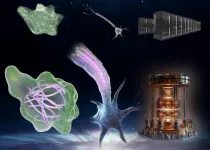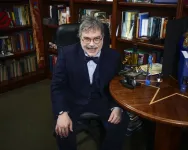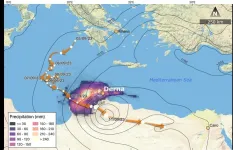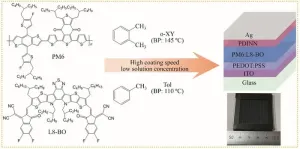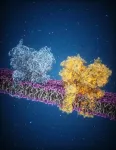WASHINGTON, DC – (March 28, 2025) More than 80 years ago, Erwin Schrödinger, a theoretical physicist steeped in the philosophy of Schopenhauer and the Upanishads, delivered a series of public lectures at Trinity College, Dublin, which eventually came to be published in 1944 under the title What is Life?
Now, in the 2025 International Year of Quantum Science and Technology, Philip Kurian, a theoretical physicist and founding director of the Quantum Biology Laboratory (QBL) at Howard University in Washington, D.C., has used the laws of quantum mechanics, which Schrödinger postulated, and the QBL’s discovery of cytoskeletal filaments exhibiting quantum optical features, to set a drastically revised upper bound on the computational capacity of carbon-based life in the entire history of Earth. Published in Science Advances, Kurian’s latest work conjectures a relationship between this information-processing limit and that of all matter in the observable universe.
“This work connects the dots among the great pillars of twentieth century physics—thermodynamics, relativity, and quantum mechanics—for a major paradigm shift across the biological sciences, investigating the feasibility and implications of quantum information processing in wetware at ambient temperatures,” said Kurian. “Physicists and cosmologists should wrestle with these findings, especially as they consider the origins of life on Earth and elsewhere in the habitable universe, evolving in concert with the electromagnetic field.”
QUANTUM MECHANICS AND SUPERRADIANCE
The effects of quantum mechanics—the laws of physics that many scientists think apply at only small scales—are sensitive to disturbances. This is why quantum computers must be held at temperatures colder than outer space, and only small objects, such as atoms and molecules, typically display quantum properties. By quantum standards, biological systems are quite hostile environments: they’re warm and chaotic, and even their fundamental components—such as cells—are considered large.
But Kurian’s group last year discovered a distinctly quantum effect in protein polymers in aqueous solution, which survives these challenging conditions at the micron scale, and may also present a way for the brain to protect itself from degenerative diseases like Alzheimer’s and related dementias. Their results have suggested new applications and platforms for quantum computing researchers, and they represent a new way of thinking about the relationship between life and quantum mechanics.
In his single-author Science Advances paper, Kurian considered a mere trifecta of overarching assumptions: standard quantum mechanics, the relativistic speed limit set by light, and a matter-dominated universe at critical mass-energy density. “Combined with these rather innocuous premises, the remarkable experimental confirmation of single-photon superradiance in a ubiquitous biological architecture at thermal equilibrium opens up many new lines of inquiry across quantum optics, quantum information theory, condensed matter physics, cosmology, and biophysics,” said Professor Marco Pettini of Aix-Marseille University and the CNRS Center for Theoretical Physics (France), who was not associated with the work.
QUANTUM INFORMATION PROCESSING, BEYOND BIOCHEMICAL SIGNALING
The key molecule enabling these remarkable properties is tryptophan, an amino acid found in many proteins that absorbs ultraviolet light and re-emits it at a longer wavelength. Large networks of tryptophan form in microtubules, amyloid fibrils, transmembrane receptors, viral capsids, cilia, centrioles, neurons, and other cellular complexes. The QBL’s confirmation of quantum superradiance in cytoskeletal filaments has the profound consequence that all eukaryotic organisms can use these quantum signals to process information.
To break down food, cells undergoing aerobic respiration use oxygen and generate free radicals, which can emit damaging, high-energy UV light particles. Tryptophan can absorb this ultraviolet light and re-emit it at a lower energy. And, as the QBL study found, very large tryptophan networks can do this even more efficiently and robustly because of their powerful quantum effects.
The standard model for biochemical signaling involves ions moving across cells or membranes, generating spikes in an electrochemical process that takes a few milliseconds for each signal. But neuroscience and other biological researchers have only recently become aware that this isn’t the whole story. Superradiance in these cytoskeletal filaments happens in about a picosecond—a millionth of a microsecond. Their tryptophan networks could be functioning as quantum fiber optics that allow eukaryotic cells to process information billions of times faster than chemical processes alone would allow.
“The implications of Kurian’s insights are staggering,” said Professor Majed Chergui of the École Polytechnique Fédérale de Lausanne (Switzerland) and Elettra-Sincrotrone Trieste (Italy), who supported the 2024 experimental study. “Quantum biology—in particular our observations of superradiant signatures from standard protein spectroscopy methods, guided by his theory—has the potential to open new vistas for understanding the evolution of living systems, in light of photophysics.”
ANEURAL LIFE AND PLANETARY COMPUTING CAPACITY
By thinking of biological information processing primarily at the level of the neuron, many scientists overlook the fact that aneural organisms—including bacteria, fungi, and plants, which form the bulk of Earth’s biomass—perform sophisticated computations. And as these organisms have been on our planet for much longer than animals, they constitute the vast majority of Earth’s carbon-based computation.
“There are signatures in the interstellar media and on interplanetary asteroids of similar quantum emitters, which may be precursors to eukaryotic life’s computational advantage,” said Dante Lauretta, professor of planetary science and cosmochemistry at the University of Arizona and director of the Arizona Astrobiology Center, who was not associated with the work. “Kurian’s predictions provide quantitative bounds, beyond the colloquial Drake equation, on how superradiant living systems enhance planetary computing capacity. The remarkable properties of this signaling and information-processing modality could be a game-changer in the study of habitable exoplanets.”
PERFORMANCE COMPARISONS WITH QUANTUM COMPUTERS
This latest analysis has likewise drawn the attention of researchers in quantum computing, because the survival of fragile quantum effects in a “noisy” environment is of great interest to those who want to make quantum information technology more resilient. Kurian has had conversations with several quantum computing researchers who were surprised to find such connections in the biological sciences.
"These new performance comparisons will be of interest to the large community of researchers in open quantum systems and quantum technology," said Professor Nicolò Defenu of the Federal Institute of Technology (ETH) Zurich in Switzerland, a quantum researcher who was not associated with the work. "It's really intriguing to see a vital and growing connection between quantum technology and living systems."
In the Science Advances article, Kurian explains and revisits foundational quantum properties and thermodynamic considerations, from a long line of physicists who made clear the essential link between physics and information. With his group's discovery of UV-excited qubits in biological fibers, almost all life on Earth has the physical capacity to compute with controllable quantum degrees of freedom, allowing storage and manipulation of quantum information with error correction cycles far outpacing the latest lattice-based surface codes. "And all this in a warm soup! The quantum computing world should take serious notice," Kurian said.
The work also piqued the attention of quantum physicist Seth Lloyd, a professor of mechanical engineering at MIT and a pioneer in the study of quantum computing and the computational capacity of the universe. “I applaud Dr. Kurian’s bold and imaginative efforts to apply the fundamental physics of computation to the total amount of information processing performed by living systems over the course of life on Earth. It’s good to be reminded that the computation performed by living systems is vastly more powerful than that performed by artificial ones,” Lloyd said.
“In the era of artificial intelligences and quantum computers, it is important to remember that physical laws restrict all their behaviors,” Kurian said. “And yet, though these stringent physical limits also apply to life’s ability to track, observe, know, and simulate parts of the universe, we can still explore and make sense of the brilliant order within it, as the cosmic story unfolds. It’s awe-inspiring that we get to play such a role.”
# # #
About the institution: Howard University
Howard University, established in 1867, is a leading private research university based in Washington, D.C. Howard’s 14 schools and colleges offer 140 undergraduate, graduate, and professional degree programs and lead the nation in awarding doctoral degrees to African American students. Howard is the top-ranked historically Black college or university (HBCU) according to Forbes and is the only HBCU ranked among U.S. News & World Report’s Top 100 National Universities. Renowned for its esteemed faculty, high achieving students, and commitment to excellence, leadership, truth, and service, Howard produces distinguished alumni across all sectors, including the first Black U.S. Supreme Court justice and the first woman U.S. vice president; Schwarzman, Marshall, Rhodes, and Truman Scholars; prestigious fellows; and over 165 Fulbright recipients. For more information, please visit https://www.howard.edu.
About the scientists: Quantum Biology Laboratory
With a transformative vision that extends from the subatomic to the clinical scale, the Quantum Biology Laboratory studies how collective behaviors in living matter can be manifested and controlled for the development of advanced tools, diagnostics, and therapies to address complex and degenerative disorders. Investigators in the Quantum Biology Laboratory use techniques from quantum optics, quantum information, protein spectroscopy, structural/molecular biology, and high-performance computing to solve an array of problems relevant to quantum effects in living processes. For more information, please visit https://www.quantumbiolab.com/.
About the author and principal investigator: Philip Kurian, Ph.D.
Dr. Philip Kurian is a theoretical physicist, (re)search(ing) scientist, and essayist, serving as principal investigator and founding director of the Quantum Biology Laboratory (https://quantumbiolab.com/) at Howard University. Beginning his career as a math teacher in North Philadelphia, he completed his doctorate in physics after a stint at NASA Goddard Space Flight Center. Dr. Kurian is now the recipient of fellowships, grants, and awards from the Alfred P. Sloan Foundation, U.S.-Italy Fulbright Commission, Guy Foundation Family Trust (UK), National Science Foundation, and the National Institutes of Health. The Quantum Biology Laboratory studies how collective and cooperative quantum behaviors can explain biological phenomena at the mesoscopic, organismal, and clinical scales, including in neurodegeneration, cancer, and human consciousness. His group’s pioneering work on single-photon superradiance in eukaryotic protein filaments and neuron fibers has been featured by Science, The Quantum Insider, Oak Ridge Leadership Computing Facility, SPIE Photonics Focus, Optica, Laser Focus World, BioPhotonics, Howard Magazine, TEDx, and by prominent science channels including Science News with Sabine and PBS Space Time. Dr. Kurian is a Fellow of the UCSB Kavli Institute for Theoretical Physics, and a Simons Scholar and Senior Fellow at the UCLA Institute for Pure and Applied Mathematics. He was appointed to the chairing committee for the National Academies of Sciences, Engineering, and Medicine workshop on quantum-enabled sensing and imaging for biology. Dr. Kurian also serves as a scientific advisor to the “Science for Seminaries” program of the AAAS Dialogue on Science, Ethics, and Religion, which seeks to integrate frontier science questions into conversations among future theologians and clergy. His essays on science, human knowledge systems, and empire have appeared in various media outlets, including the Los Angeles Review of Books, Granta, and Plough. For more information, please visit https://profiles.howard.edu/philip-kurian.
END
